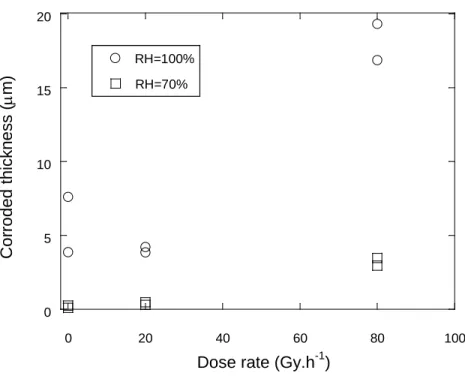HAL Id: hal-02445722
https://hal-cea.archives-ouvertes.fr/hal-02445722
Submitted on 20 Jan 2020HAL is a multi-disciplinary open access
archive for the deposit and dissemination of sci-entific research documents, whether they are pub-lished or not. The documents may come from teaching and research institutions in France or abroad, or from public or private research centers.
L’archive ouverte pluridisciplinaire HAL, est destinée au dépôt et à la diffusion de documents scientifiques de niveau recherche, publiés ou non, émanant des établissements d’enseignement et de recherche français ou étrangers, des laboratoires publics ou privés.
Radiolysis influence on low alloy steel atmospheric
corrosion at 80°C
S. Perrin, J.M. Lameille, M. Fenart, P. Le Tutour
To cite this version:
S. Perrin, J.M. Lameille, M. Fenart, P. Le Tutour. Radiolysis influence on low alloy steel atmospheric corrosion at 80°C. LTC 9992016 - 6th International Workshop on Long-term Prediction of Corrosion Damage in Nuclear Waste Systems, May 2016, Toronto, Canada. �hal-02445722�
6th International Workshop on Long-term Prediction of Corrosion Damage in Nuclear Waste Systems Toronto, Ontario, Canada, May 9-12, 2016
Radiolysis influence on low alloy steel atmospheric corrosion at 80°C S. PERRIN1, J. M. LAMEILLE1, M. FENART1, P. LE TUTOUR2.
1 CEA, DEN, DPC, SCCME, Laboratoire d’Étude de la Corrosion Aqueuse, F-91191
Gif-sur-Yvette, France
2 CEA, DEN, DRSN, SEROS, LABoratoire des Rayonnements Appliqués, F-91191
Gif-sur-Yvette, France
ABSTRACT
The degradation of iron-based materials by atmospheric corrosion is a well-known problem that may have incidence, especially for the storage of radioactive nuclear wastes. It is of importance to evaluate the damages due to this kind of corrosion within long time-periods. One parameter which can influence atmospheric corrosion in the case of storage container is irradiation. As atmospheric corrosion happens when a water film condensates at the surface of a material, radiolysis of this water film in contact with air can have for consequence the formation of acid an oxidizing species which can modify the corrosion process.
As a consequence the aim of this work is to evaluate the influence of γ-irradiation on atmospheric corrosion of low alloy steel. In this goal, an experiment, called CASIMIR, has been developed. During this experiment, samples of low alloy steel have been introduced into small stainless steel container. In these ones, two different media has been introduced. The first medium is a small quantity of water in order to fix a relative humidity (RH) of 100 %. The second medium is a melt of KH2PO4/ K2HPO4 in a small quantity of water corresponding to a
relative humidity of about 70% at the surface of the samples. The small containers have been introduced in a heating system which enables to fix a temperature of 80°C. This system has been installed in an irradiation pool with three 60Co sources which fix, according to the location of the stainless steel in the system, a dose rate of 80 Gy.h-1 or 20 Gy.h-1at the surface of the low alloy steel samples.
After six, nine and twelve months of corrosion in these conditions some samples were extracted of the experiment and analyzed by different methods. Gravimetry after desquamation of the corrosion layer enables to measure total corroded thickness in function of RH, dose rate and time. As show on figure 1, after 6 month of exposure, sample aged with a RH of 100% are more corroded than the one aged at 70%. Moreover the dose rate does not have an effect on the corroded thickness for 20 Gy.h-1 whereas it increases corrosion when the dose rate is equal to 80 Gy.h-1. This result is confirmed for longer times. Gas analysis after corrosion experiment have
shown that for the higher corrosion rate, oxygen was totally consumed after 6 month and reveal also a production of hydrogen. Microscopical observations also confirm the influence of dose rate on atmospheric corrosion.
All the results show that dose rate does not influence atmospheric corrosion until a value between 20 and 80 Gy.h-1. For a dose rate up to these thresholds, irradiation increase corrosion rate on low alloy steel in presence of high values of relative humilities.
6th International Workshop on Long-term Prediction of Corrosion Damage in Nuclear Waste Systems Toronto, Ontario, Canada, May 9-12, 2016
0 5 10 15 20 0 20 40 60 80 100 RH=100% RH=70% C o rro d e d t h ickn e ss (µ m)
Dose rate (Gy.h-1)
Figure 1 : Corroded thickness on low alloy steel in function of dose rater after 6 month of corrosion for RH of 70% and for RH of 100%
